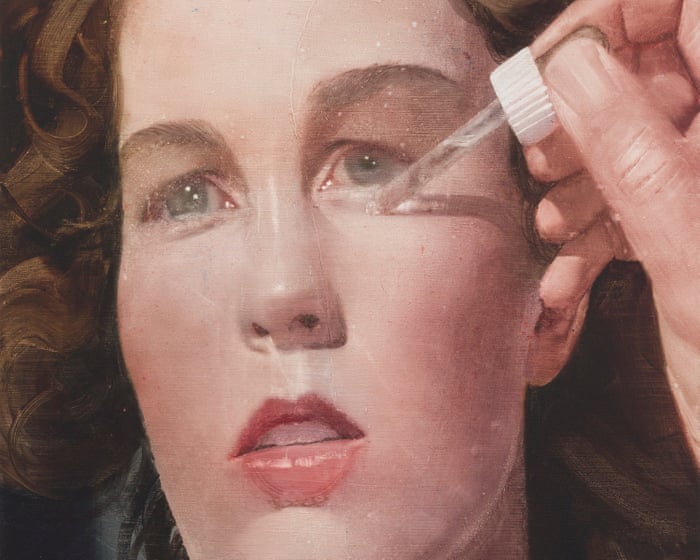Joseph Yaeger believes that “all paintings are in their own way accusations and confessions,” which is the central theme of his new exhibition, “Polygrapher.” This show is his first since joining the prestigious London gallery Modern Art in 2024 and also marks the opening of the gallery’s new location in St James’s.
Yaeger values honesty, shaped by his upbringing in Helena, a town in the U.S. that he notes ambitiously calls itself the capital of Montana. His childhood was decent but unremarkable: “We’d sit down for dinner together every night, go to church every Sunday, and were polite almost to a fault, traditional in almost every sense.”
His strong work ethic reflects his solid upbringing. When we met in his studio about a week before the exhibition opened, the 17 paintings for “Polygrapher” were already finished and gone. Instead, the walls were covered with canvases destined for his New York gallery, Gladstone, next year. “I work many months ahead, probably as a way of dealing with my own anxieties,” he admits with self-deprecation.
Though his early aspirations to be a filmmaker were cut short by realizing he is “a very poor manager,” his paintings blend careful planning with chance. “Truly,” he says, “a lot of times the work just happens in front of you.”
Now 39, Yaeger earned a Master’s from London’s Royal College of Art in 2019 and has become a talked-about figure in art circles. He works exclusively with watercolor over gesso—a hard-drying white primer made from gypsum—on canvas or linen. From a distance, his often large-scale paintings resemble film stills, capturing details like the shine of a wet lip or the delicate crease of an eyelid with glossy, hyperreal intensity. Up close, however, the surfaces reveal scars, pockmarks, and deep, regular cracks reminiscent of a dried-up riverbed.
The figures in his paintings are sourced from film stills, removed from their original contexts. Yaeger’s personal touch is visible in the inclusion of materials like pistachio shells, dust from his studio floor, or a biscuit wrapper, embedded in the surface like a dog’s footprint in wet cement.
For each exhibition, Yaeger writes a text. For “Polygrapher,” it’s presented as the transcript of a polygraph test he took, showing only his answers. This fragmented document weaves together a voyeuristic encounter with a neighbor, memories of his work, his daughter, his Catholic upbringing, and art criticism.
When asked if he actually took a polygraph test, Yaeger responds cryptically: “In all important senses.” He adds that he believes polygraphs were “debunked ages ago. As a means of discovering the truth, they’re clumsy and kind of stupid. But as a metaphor, they carry so much meaning—it’s really powerful and dark. It doesn’t surprise me that the Trump administration used polygraphs; it’s very Trump-administration coded.”
In contrast to the controlled compliance of the transcript, his paintings are wild and ungovernable, like raw memories. Is a face held with violent force or erotic passion? Are eyes hidden behind a mask complicit or terrified?Sign up for our newsletter with your email address.
Privacy Notice: Our newsletters may include details about charities, online advertisements, and content sponsored by external organizations. If you don’t have an account, we’ll set up a guest account for you on theguardian.com to deliver the newsletter. You can finish the full registration process whenever you like. To learn more about how we handle your data, please refer to our Privacy Policy. We use Google reCaptcha for website security, and the Google Privacy Policy and Terms of Service are applicable.
After the newsletter promotion:
“Once the text is complete, I start sorting through my collection of images and memories,” Yaeger explains. “I enter these deep flow states where you lose yourself completely while painting, immersing in an inner world that words can’t capture when you return.” He sees the frequent emergence of darkness in his paintings as part of the journey. “There are no profound, endless psychological scars,” he says about himself. “I believe some of us are just born with a sense of melancholy.”
View the full image: Let the Record Show What I Cannot Confess, 2025. Illustration: © Joseph Yaeger. Courtesy of the artist and Modern Art.
Although he no longer practices, Yaeger’s Catholic background remains ingrained. His painting Clean Windows Kill Birds, depicting a woman’s face through a confessional screen, is one of many with overt Catholic themes. A penitential drive leads him to embrace the challenges in his work, such as painting on the floor for hours and grappling with the inherent clash between watercolor and gesso.
Consequently, many failed paintings lie beneath the surface, visible on the raw edges of his unframed canvases, which are layered with hardened gesso and pigment. Yaeger notes that gesso allows the paint to be entirely wiped away: “I could erase this completely.” Yet, at the edges, he chooses to tell another story—perhaps the most crucial one, about our innate desire to leave a mark and be remembered.
Joseph Yaeger: Polygrapher is on display at Modern Art, 8 Bennet Street, London, from November 15 to January 17.
Frequently Asked Questions
Of course Here is a list of FAQs about Sex Lies and Pistachio Shells The Troubling Dreamscapes of Artist Joseph Yaeger written in a natural conversational tone
General Beginner Questions
1 Who is Joseph Yaeger
Joseph Yaeger is a contemporary artist known for his haunting and dreamlike paintings that often rework and subvert historical art images
2 What is the main theme of this exhibition Sex Lies and Pistachio Shells
The exhibition explores themes of memory desire truth and deception creating troubling dreamscapes that feel both familiar and unsettling
3 Why are pistachio shells mentioned in the title Are they in the art
Yes pistachio shells sometimes appear in his work as textural elements or symbolic objects representing something mundane that intrudes upon a poetic or dramatic scene
4 What kind of art does he make
He primarily creates paintings often using a technique where he thins his oil paints to a watery consistency similar to watercolor on a slick surface This gives his work a delicate ghostly and fluid appearance
5 Is his work abstract or figurative
Its primarily figurative He often paints recognizable subjectslike faces or figuresbut distorts and obscures them blurring the line between reality and a dream
Deeper Advanced Questions
6 What does troubling dreamscapes mean in the context of his work
It refers to the way his paintings feel like dreams you cant quite remember clearlythey are beautiful but also evoke a sense of anxiety loss or something hidden
7 How does Yaeger use art history in his paintings
He frequently uses old master paintings or historical photographs as a starting point He then alters themby cropping blurring or adding contemporary elementsto challenge the original meaning and create a new personal narrative
8 What is the significance of the lies in the title
The lies point to the idea that memory and images are unreliable His paintings show how a single image or memory can be manipulated faded or reinterpreted questioning what is true
9 Can you explain his technique a bit more Why is it unique
He paints with oils on a nonabsorbent synthetic paper called




